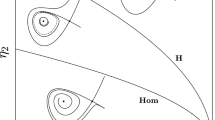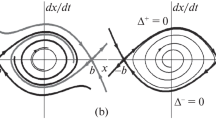Abstract
We consider a one dimensional time dependent ODE of degree \(n\ge 2\) as the restriction of an arbitrary nonautonomous ODE to the associated one dimensional center manifold. Then, we present an algorithm for computing time dependent algebraic curves of m-th degree with \(m\le n-1\). This computation leads us to a m dimensional time dependent bifurcation equation. We determine oscillatory behaviors of the system with the help of the bifurcation equation. Finally, we complete the method for a general parametric planar system and find periodic solutions. The method can be applied for a wide range of nonautonomous systems and does not have restrictions of classical methods such as the Poincaré map.
Similar content being viewed by others
Notes
Furthermore since H is invertible so \(R(t)=-H^{-1}(e^{-tH}-I)/t\), this does not hold for C in general
References
Algaba, A., Checa, I., Garcia, C., Gine, J.: Analytic integrability inside a family of degenerate centers. Nonlinear Anal. Real World Appl. 31, 288–307 (2016)
Aulbach, B.: A reduction principle for nonautonomous differential equations. Arch. Math. 39, 217–232 (1982)
Candido, M.R., Llibre, J., Valls, C.: Non-existence, existence, and uniqueness of limit cycles for a generalization of the Van der Pol-Duffing and the Rayleigh-Duffing oscillators. Physica D 407, 132458 (2020)
Candido, M.R., Novaes, D.D.: On the torus bifurcation in averaging theory. J. Differ. Equ. 268, 4555–4576 (2020)
Cheng, H., de la Llave, R.: Time dependent center manifold in PDEs. Discrete Contin. Dyn. Syst. 40(12), 6709–6745 (2020)
Church, K.E.M., Liu, X.: Computation of center manifolds and some codimension-one bifurcations for impulsive delay differential equations. J. Differ. Equ. 267, 3852–3921 (2019)
da Cruz, L.P.C., Torregrosa, J.: Simultaneous bifurcation of limit cycles from a cubic piecewise center with two period annuli. J. Math. Anal. Appl. 461, 248–272 (2018)
Darboux, G.: Memoire sur les equations differentielles algebriques du premier ordre et du premier degre(Melanges). Bull. Sci. Math 2, 60–96, 123–144, 151–200 (1878)
Fabbri, R., Johnson, R.: A nonautonomous saddle-node bifurcation pattern. Stochastics Dyn. 4(3), 335–350 (2004)
Franca, M., Johnson, R.: Remarks on nonautonomous bifurcation theory. Rend. Istit. Mat. Univ. Trieste 49, 215–243 (2017)
Franca, M., Johnson, R.: On the non-autonomous Hopf bifurcation problem: systems with rapidly varying coefficients. Electron. J. Qual. Theory Differ. Equ. 56, 1–24 (2019)
Franca, M., Johnson, R., Munoz-Villarragut, V.: On the nonauotonomous Hopf bifurcation problem. Discrete Contin. Dyn. Syst. Ser. S 9(4), 1119–1148 (2016)
Guo, L., Yu, P., Chen, Y.: Bifurcation analysis on a class of \(Z_{2}\)-equivariant cubic switching systems showing eighteen limit cycles. J. Differ. Equ. 266, 1221–1244 (2019)
Kelley, A.: The stable, center-stable, center, center-unstable, unstable manifolds. J. Differ. Equ. 3, 546–570 (1967)
Kloeden, P.E., Potzsche, C.: Nonautonomous bifurcation scenarios in SIR models. Math. Meth. Appl. Sci. 38, 3495–3518 (2015)
Kloeden, P.E., Rasmussen, M.: Nonautonomous Dynamical Systems. American Mathematical Society (2011)
Knobloch, H.W., Aulbach, B.: The role of center manifolds in ordinary differential equations. BSB B.G. Teubner Verlagsgesellschaft 47, 179–189 (1982)
Li, J., Quan, T., Zhang, W.: Bifurcation and number of subharmonic solutions of a 4D non-autonomous slow-fast system and its application. Nonlinear Dyn. 92, 721–739 (2018)
Llibre, J., Pantazi, Ch.: Darboux theory of integrability for a class of nonautonomous vector fields. J. Math. Phys. 50, 102705 (2009)
Llibre, J., Ramirez, R., Ramirez, V.: An inverse approach to the center problem. Rend. Circ. Mat. Palermo, II. Ser (2018)
Llibre, J., Swirszcz, G.: Relationships between limit cycles and algebraic invariant curves for quadratic systems. J. Differ. Equ. 229, 529–537 (2006)
Malkin, I.G.: Theory of Stability of Motion. U.S. Atomic Energy Commission, Office of Technical Information (1959)
Molnar, T.G., Dombovari, Z., Insperger, T., Stepan, G.: Bifurcation analysis of nonlinear time-periodic time-delay systems via semidiscretization. Int. J. Numer. Methods Eng. 115, 57–74 (2018)
Perko, L.: Differential Equations and Dynamical Systems, 3rd edn. Springer, New York (2001)
Poincaré, H.: Sur l’equilibre d’une masse fluide animee d’un mouvement de rotation. Acta Mathematica 7, 259–380 (1885)
Potzsche, C., Rasmussen, M.: Taylor approximation of integral manifolds. J. Dyn. Differ. Equ. 18(2), 427–460 (2006)
Sell, G.R.: The structure of a flow in the vicinity of an almost periodic motion. J. Differ. Equ. 27, 359–393 (1978)
Sheng, L., Wang, S., Li, X., Han, M.: Bifurcation of periodic orbits of periodic equations with multiple parameters by averaging method. J. Math. Anal. Appl. 490, 124311 (2020)
Sinha, S.C.: On the analysis of time-periodic nonlinear dynamical systems. Sadhana 22(3), 411–434 (1997)
Szalai, R., Stepan, G.: Period doubling bifurcation and center manifold reduction in a time-periodic and time-delayed model of machining. J. Vib. Control 16(7–8), 1169–1187 (2010)
Virgin, L.N., Thompson, J.M.T.: Applications of bifurcation: nonautonomous periodically-excited systems. Int. J. Bifurc. Chaos 28(11), 1830035 (2018)
Wiggins, S.: Introduction to Applied Nonlinear Dynamical Systems and Chaos. Springer, New York (1990)
Xu, J., Yu, P.: Delay-induced bifurcations in a nonautonomous system with delayed velocity feedbacks. Int. J. Bifurc. Chaos 14(8), 2777–2798 (2004)
Author information
Authors and Affiliations
Corresponding author
Additional information
Publisher's Note
Springer Nature remains neutral with regard to jurisdictional claims in published maps and institutional affiliations.
Appendix
Appendix
Here, we give an illustration to show how the time dependent algebraic curves work. We assume \(n=2\) and consider two cases \(m =1<n\) and \(n\le m=3\) (see Remark 1). Consider the equation
where \(a_0(t)\) and \(a_2(t)\) are not identically zero. We begin with the trivial case \(m=1\) and try to find an algebraic curve as \(F(x,t)=b_0(t)+x\). In this case, the cofactor curve K(x, t) is of the form \(K(x,t)=c_0(t)+c_1(t)x(t)\), and we have
or equivalently
It implies that \(c_0(t)=a_1(t)-c_1(t) b_0(t)\), \(c_1(t)=a_2(t)\), and
Note that, if \(b_0(t)\) is a solution of the above equation, then \(x(t)=-b_0(t)\) is a solution of (42); Especially, if \(b_0(t)\) is periodic, then x(t) is periodic too.
Now, let \(m=3\) and try for an algebraic curve of the form
From Remark 1, we consider (42) in the form
with \(a_3(t),a_4(t)\equiv 0\) and the cofactor curve of the form
Thus,
It implies that \(c_3(t)=c_2(t)\equiv 0\), \(c_1(t)=3a_2(t)\), \(c_0(t)=3 a_1(t)-a_2(t) b_2(t)\), and
It is easy to check that the above equalities are in agreement with Remark 1.
In an especial case, let
It can be checked directly from (44) that
is a solution for (44), and thus a solution for (19). Finally, it is easy to see that \(F(\sin (t),t)\equiv 0\), which means that \(x(t)=\sin t\) is a solution of (42). This fact can also be verified by putting \(x(t)=\sin t\) in (42).
As another example, let \(m=3\), \(n=4\) with \(a_4(t) \ne 0\) and consider the equation
In this case, the algebraic curve is of the form
with the corresponding cofactor \(K(t)=c_0(t)+c_1(t)x+c_{2}(t)x^{2} +c_3(t)x^{3}\). By using (14), (15), and (16), we find
Substituting the above relations in the differential part of (13), we obtain
In an especial case, let
Then \(F(t) = b_0(t)+b_1(t)x+x^{3}\) is an algebraic curve for the equation (45) where
is the solution of (46) and the corresponding cofactor curve \(K(t) = c_0(t)+c_1(t)x+c_3(t)x^{3}\) is given by
Finally, \(x(t)=\sin (t)\) is a solution of \(F(x(t),t) \equiv 0\), and thus (45) has a periodic orbit.
Rights and permissions
About this article
Cite this article
Rabiei Motlagh, O., Molaei Derakhtenjani, M. & Mohammadi Nejad, H.M. Oscillations on one dimensional time dependent center manifolds: algebraic curves approach. Collect. Math. 73, 433–456 (2022). https://doi.org/10.1007/s13348-021-00328-3
Received:
Accepted:
Published:
Issue Date:
DOI: https://doi.org/10.1007/s13348-021-00328-3




